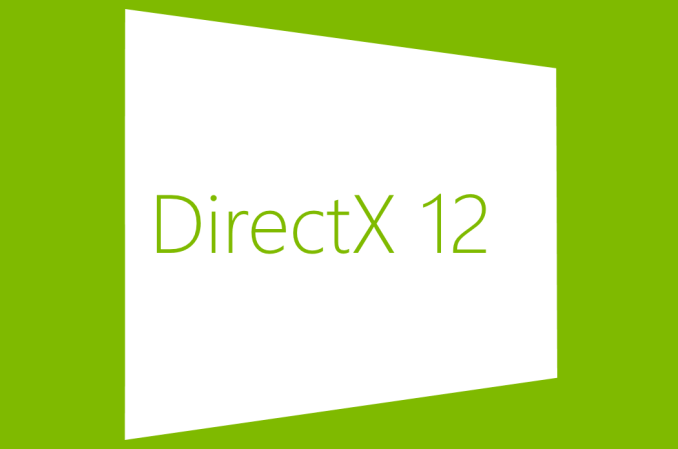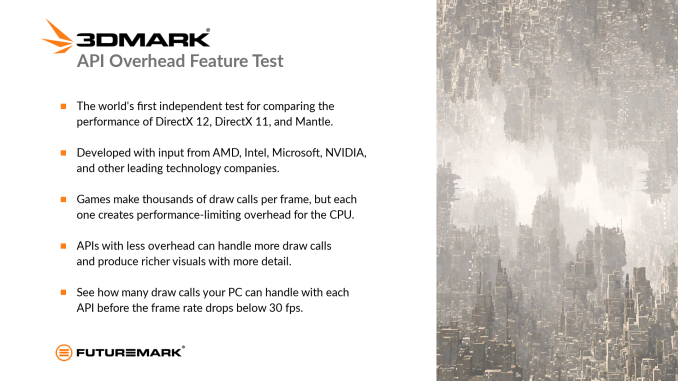Exploring DirectX 12: 3DMark API Overhead Feature Test
by Ryan Smith & Ian Cutress on March 27, 2015 8:00 AM EST- Posted in
- GPUs
- Radeon
- Futuremark
- GeForce
- 3DMark
- DirectX 12

To say there’s a bit of excitement for DirectX 12 and other low-level APIs is probably an understatement. A big understatement. With DirectX 12 ramping up for a release later this year, Mantle 1.0 already in pseudo-release, and its successor Vulkan under active development, the world of graphics APIs is changing in a way not seen since the earliest days, when APIs such as Direct3D, OpenGL, and numerous vendor proprietary APIs were first released. From a consumer standpoint this change will still take a number of years, but from a development standpoint 2015 is going to be the year that everything changed for PC graphics programming.
So far much has been made about the benefits of these APIs, the potential performance improvements, and ultimately what can be done and what new things can be achieved with them. The true answer to those questions are that this is going to be a multi-generational effort; until games are built from the ground-up for these APIs, developers won’t be able to make full use of their capabilities. Even then, the coolest tricks will take some number of years to develop, as developers become better acquainted with these new APIs, their idiosyncrasies, and the capabilities of the underlying hardware when interfaced with these APIs. In other words, right now we’re just scratching the surface.
The first DirectX 12 games are expected towards the end of the year, and in the meantime Microsoft and their hardware partners have been ramping up the DirectX 12 ecosystem, hammering out the API implementation in Windows 10 while the hardware vendors write and debug their WDDM 2.0 drivers. Meanwhile as this has been going on, we’ve seen a slow release of software released designed to showcase DirectX 12 features in a proof of concept manner. A number of various internal demos exist, and we saw the first semi-public DirectX 12 software release last month with our look at Star Swarm.
This week the benchmarking gurus over at Futuremark are releasing their own first run at a DirectX 12 test with their latest update for the 3DMark benchmark. Futuremark has been working away at DirectX 12 for some time – in fact they were the first partner to show DirectX 12 code in action at Microsoft’s 2014 DX12 unveiling – and now they are releasing their first DirectX 12 project.
In keeping with the general theme of the demos we’ve seen so far, Futuremark’s new DirectX 12 release is another proof of concept test. Dubbed the 3DMark API Overhead Feature Test, this benchmark is a purely synthetic benchmark designed to showcase the draw call benefits of the new API even more strongly than earlier benchmarks. Whereas Star Swarm was a best-case scenario test within the confines of a realistic graphics workload, the API Overhead Feature Test is a proper synthetic benchmark that is designed to test one thing and one thing only: how many draw calls a system can handle. The end result, as we’ll see, showcases just how great the benefits of DirectX 12 are in this situation, allowing for an order of magnitude’s improvement, if not more.
To do this, Futuremark has written a relatively simple test that draws out a very simple scene with an ever-increasing number of objects in order to measure how many draw calls a system can handle before it becomes saturated. As expected for a synthetic test, the underlying rendering task is very simple – render an immense amount of building-like objections at both the top and bottom of the screen – and the bottleneck is in processing the draw calls. Generally speaking, under this test you should either be limited by the number of draw calls you can generate (CPU limited) or limited by the number of draw calls you can consume (GPU’s command processor limited), and not the GPU’s actual rendering capabilities. The end result is that the API Overhead Feature Test can push an even larger number of draw calls than Star Swarm could.
To showcase the difference between various APIs, this test is available with DirectX 12 and Mantle, but also two different DirectX 11 modes. Standard DirectX 11 single-threading is one mode, alongside support for DirectX 11 multi-threading. The latter has a checkered history – it never did work as well in the real world as initially hoped – and in practice only NVIDIA supports it to any decent degree. But regardless, as we’ll see DirectX 12’s throughput will put even DX11MT to shame.
FutureMark’s complete technical description is posted below:
The test is designed to make API overhead the performance bottleneck. The test scene contains a large number of geometries. Each geometry is a unique, procedurally-generated, indexed mesh containing 112 -127 triangles.
The geometries are drawn with a simple shader, without post processing. The draw call count is increased further by drawing a mirror image of the geometry to the sky and using a shadow map for directional light.
The scene is drawn to an internal render target before being scaled to the back buffer. There is no frustum or occlusion culling to ensure that the API draw call overhead is always greater than the application side overhead generated by the rendering engine.
Starting from a small number of draw calls per frame, the test increases the number of draw calls in steps every 20 frames, following the figures in the table below.
To reduce memory usage and loading time, the test is divided into two parts. The second part starts at 98304 draw calls per frame and runs only if the first part is completed at more than 30 frames per second.
Draw calls per frame Draw calls per frame increment per step Accumulated duration in frames 192 – 384 12 320 384 – 768 24 640 768 – 1536 48 960 1536 – 3072 96 1280 3072 – 6144 192 1600 6144 – 12288 384 1920 12288 – 24576 768 2240 24576 – 49152 1536 2560 49152 – 98304 3072 2880 98304 – 196608 6144 3200 196608 – 393216 12288 3520












113 Comments
View All Comments
chizow - Friday, March 27, 2015 - link
Yeah buddy! Bring on DX12, aka Low Level API Done Right.Also fun to note all the rumors and speculation of AMD's poor DX11 MT driver support look to be real (virtually no DX11 ST to MT scaling and both lower than Nvidia DX11), but it is also obvious their efforts with Mantle have given them a nice base for their DX12 driver, at least in synthetic max draw call tests.
Main benefits for DX12 will be for CPU limited games on fast hardware, especially RTS and MMO type games where the CPU tends to be the bottleneck. It will also be interesting to see what impact it has on higher-end set-ups like high-end multi-GPU. Mantle was supposed to show us the benefits in scaling, but due to piecemeal support and the fact multi-GPU needed much more attention with Mantle, CF was often left in a broken state.
Barilla - Friday, March 27, 2015 - link
I really hope dx12 and it's increase in draw call throughput will bring us greater scene complexity, i mean more "real" objects that could be interacted with rather than tricks like textures that make us think there is depth to them while in reality it's just clever artwork. Also objects like leaves, stones, grass etc. I think this would bring much better immersion in the games than just trying to constantly up the polygon count on characters and find new ways to animate hair. Maybe I'm the odd one, but i often focus much more on the game world rather than the characters.MobiusPizza - Friday, March 27, 2015 - link
I can see how FutureMark can help make the next gen MineCraft title :Ptipoo - Friday, March 27, 2015 - link
Can Intel do any more on the driver side to see more DX12 gains, or is it all GPU front end limited at this point?mczak - Friday, March 27, 2015 - link
I suspect for the chips listed it's about as good as it will get. Note that these are all Haswell GT2 chips - GT3 doubles up on some fixed function blocks in the frontend, though I don't know if it would help (the command streamer is supposedly the same so if it's limited there it wouldn't help).The results could be better with Broadwell, though (be it GT2 or GT3).
tipoo - Friday, March 27, 2015 - link
The older article on DX12 showed GT3/3e don't see much more gain past GT2, because while many things are doubled, the front end isn't. Command input limited.I haven't heard that Broadwell is different there.
eanazag - Friday, March 27, 2015 - link
DX12 is exciting for PC laptop and tablet gaming.My desktop can heat the room when gaming and I believe that DX12 and FPS limits could allow me to play cooler next summer. I'd like to see some FPS limiting options if it can reduce heat. During the winter I don't care. I pretty much stop gaming during the summer; at least with the desktop.
martixy - Friday, March 27, 2015 - link
I like this. Very much. The industry needs a clean reset and this is a perfect opportunity...Now if only the business side was as easy to overhaul as the technical side. :)
KaarlisK - Friday, March 27, 2015 - link
I can see the 4770R (GT3e) in the system specifications, but I do not see it in any of the charts. What happened?tipoo - Friday, March 27, 2015 - link
That one I'd definitely be interested in, would the higher bandwidth it has allow any more DX12 gains?